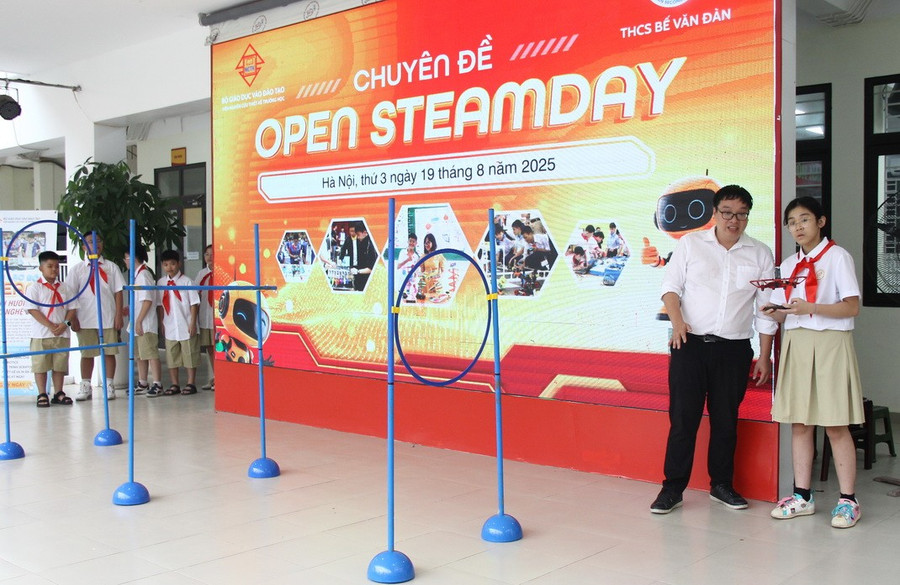Breakthrough thinking from decades of educational practice
According to teacher Tran Trung Hieu - History teacher, Phan Boi Chau High School for the Gifted ( Nghe An ), since the 6th Party Congress in 1986, comprehensive and synchronous innovation has been affirmed, in which education and training is the key area.
Over nearly four decades, many important policies and guidelines have been issued, such as Resolution 29-NQ/TW on fundamental and comprehensive innovation in education and training, or Resolution 88/2014/QH13 of the National Assembly on innovation in general education programs and textbooks.
In fact, the Party and the State always consider education, along with science and technology, as the top national policy. However, education and training have not really become the key driving force for the country's breakthrough development.
At many levels, sectors and localities, the viewpoint that “education is the top national policy and the cause of the entire people” has not yet been deeply imbued and vigorously implemented. Therefore, the requirement for a breakthrough resolution is inevitable, especially in the context of the country implementing a two-tier government model, requiring education to make solid progress to meet development requirements.
Key highlights of Resolution 71-NQ/TW
According to Mr. Hieu, the most important keyword of Resolution 71-NQ/TW is “breakthrough”. From the perspective of a teacher who directly teaches in the classroom, he believes that the resolution has touched on core issues and cleared many “bottlenecks” of education.
Firstly, the resolution places education and training development in the mindset of national and social governance, closely linked to the socio-economic development strategy. This affirms that education is not just a separate sector or field but the foundation of all social progress.
Second, in terms of institutions and mechanisms, Resolution 71-NQ/TW emphasizes the promotion of decentralization and delegation of power, combined with appropriate resource allocation, creating conditions for localities to be more proactive in developing education. This is a step in line with the context of the two-level government being implemented.
Third, Resolution 71-NQ/TW provides special and outstanding preferential policies for teachers. Specifically, increasing the vocational preferential allowance to a minimum of 70% for teachers and a minimum of 30% for staff; teachers in disadvantaged areas, border areas, islands and ethnic minority areas are entitled to 100%. This policy not only improves the lives of teachers but also encourages their dedication to the cause of educating people.
Fourth, Resolution 71-NQ/TW ensures the provision of a unified set of textbooks nationwide, while striving to provide free textbooks to all students by 2030. This is a humane step forward, contributing to reducing the burden of costs and ensuring equality in access to knowledge.
Fifth, the resolution clearly states the requirement to innovate the model of specialized schools and gifted schools to focus on nurturing national talents, while affirming that public education is the mainstay, while non-public education is an important part of the national education system.
Sixth, the resolution ensures full and comprehensive autonomy for higher education institutions, creating conditions for schools to promote internal strength, integrate internationally and improve training quality.
Seventh, the resolution affirms that state budget expenditure for education and training must reach at least 20% of total budget expenditure. At the same time, establish a National Scholarship Fund and effectively promote learning and talent promotion funds from many sources to encourage learning and nurture talents.
With the above highlights, Mr. Hieu commented that Resolution 71-NQ/TW not only unblocks the "bottleneck" that has lasted for many years but also creates more potential, human resources and material resources, opening up opportunities for Vietnam's education and training to develop remarkably in the new period.

To bring the resolution into life soon
Besides the positive assessment, Mr. Tran Trung Hieu also made some recommendations to quickly put Resolution 71-NQ/TW into practice.
Firstly, the Ministry of Education and Training needs to submit to the National Assembly amendments and supplements to a number of related laws, including the Law on Education, to comply with the new requirements set forth in the resolution.
Second, the Government needs to quickly concretize the resolution's content into specific, feasible policies, linked to a specific roadmap and monitoring mechanism.
Third, allocating sufficient resources for implementation is a key factor. The government needs to ensure the budget from the 2025-2026 school year so that the policy can soon be put into practice and bring about practical results.
Mr. Hieu affirmed: “With the spirit of breakthrough and high political determination, Resolution 71-NQ/TW will create a new vitality, adding motivation to the education cause, so that education truly becomes the top national policy, contributing decisively to the sustainable development of the country”.
Source: https://giaoducthoidai.vn/nghi-quyet-71-nqtw-dong-luc-dot-pha-cho-giao-duc-viet-nam-post747597.html





![[Photo] General Secretary To Lam chaired the Politburo's working session with the Standing Committees of Party Committees of Central Party agencies.](https://vphoto.vietnam.vn/thumb/1200x675/vietnam/resource/IMAGE/2025/9/9/8343386e1e8f43c6a3c0543da7744901)


![[Photo] Cambodia's Techo International Airport Officially Opens](https://vphoto.vietnam.vn/thumb/1200x675/vietnam/resource/IMAGE/2025/9/9/330836bb28ad4ee4bdd512cc1a2d0849)





























![[Photo] Politburo works with the Standing Committees of Vinh Long and Thai Nguyen Provincial Party Committees](https://vphoto.vietnam.vn/thumb/1200x675/vietnam/resource/IMAGE/2025/9/8/4f046c454726499e830b662497ea1893)


































































Comment (0)